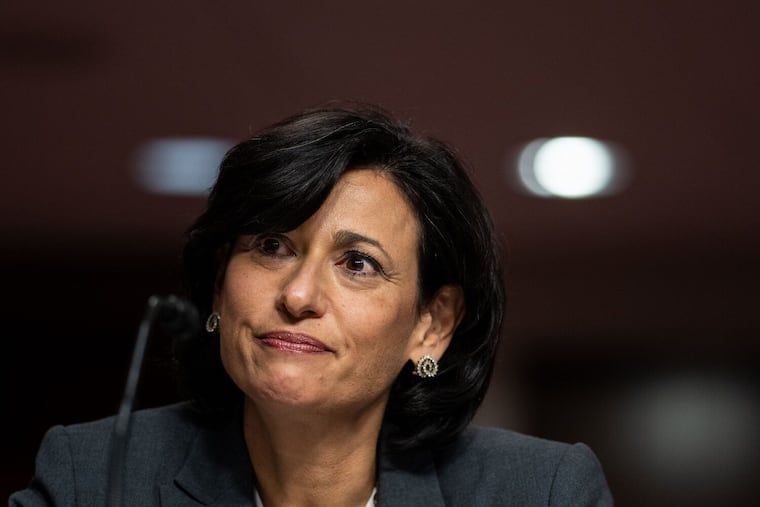In New Jersey visit, CDC chief outlines what is ahead in the pandemic
“We still have 900 deaths a day in this country. I still think we have a lot of work to do," Rochelle Walensky said during a visit to Princeton University.

As COVID-19 cases were reported to be on the rise in nine states, the director of the Centers for Disease Control and Prevention emphasized Thursday in a visit to Princeton University that the pandemic is not yet over.
“We’re not at a steady state of disease that I can be happy with,” Rochelle Walensky said. “We still have 900 deaths a day in this country. I still think we have a lot of work to do to make sure that we’re in a place that is safe for this country and for the American people.”
Just over 65% of Americans are fully immunized, and more vaccination is needed, she said, without specifying a target. She also wants more people who received their initial series of shots to get booster doses, as the newer omicron variant has had a harder time infecting those who’ve been boosted.
“We needed more protection from omicron, more immunity from omicron than we have from prior variants,” she said. “We really are working now to encourage people who really did step forward and get that primary series to have them now step forward and get that boost.”
» READ MORE: Millions still haven’t gotten COVID shots. What does that mean for the future of the vaccination effort?
The CDC director also warned that the federal government’s stalemate over additional funding for COVID-19 resources, including tests, treatments, and vaccination, is having serious consequences. Her greatest concern, Walensky said, is that health officials have the tools to prevent or treat COVID cases, but “don’t have the resources to be able to deliver to the American people.”
A $22.5 billion COVID package needed to pay for the COVID response going forward has not yet been approved by Congress. Already, the lack of funding has ended free tests for people without insurance and, Walensky said, caused a 35% reduction this week in states’ supplies of monoclonal antibodies, particularly important as a treatment for people with compromised immune systems. The funding gap will eventually limit the country’s ability to distribute another booster round of vaccine doses to all Americans, if those are approved.
“We are making decisions now that will impact the American people,” Walensky said.
Walensky acknowledged in a session with reporters at Princeton University’s Lewis Thomas Laboratory Thursday that health agencies are at a turning point in the vaccination effort: whether to prevent COVID infections, or accept that people will catch COVID, but aim to treat those cases early enough that they are less likely to cause serious illness and death. The latest COVID treatments are effective, but are costly and must be administered within days after symptoms start.
She envisions a vaccination policy that can make the latter realistic by providing enough vaccine to keep any breakthrough cases under control. It would require many booster shots to entirely prevent even mild illness, something most experts say isn’t practical.
“We want to ameliorate the severity of the disease,” she said. “I don’t know that we’ll be able to boost after boost after boost in order to eliminate any disease.”
The goals of the nation’s COVID policy will be tested in April, she said, when health officials debate recommendations over a possible fourth round of shots this fall. Pfizer has petitioned for approval for an additional shot for seniors and people with underlying health conditions. Moderna is seeking approval for an additional shot for all Americans who want it.
“Third shot, absolutely a good idea,” Walensky said. “Fourth shot, we’re still deliberating, and likely [will announce] something in the fall.”
Walensky, appointed CDC director in December 2020, was in New Jersey for a speaking engagement, dinner with students, and a meeting Friday with the state’s health department. Visits with state health officials were on hold due to pandemic concerns, but the dropping case rates nationwide have made it easier for her to travel.
» READ MORE: Money for free COVID-19 testing for all runs out amid federal funding impasse
In some places, though, case counts are climbing again, including some well-vaccinated East Coast states like New York and Massachusetts, according to New York Times data. COVID restrictions like masking and vaccination requirements are ending nationwide, but heath officials are also watching the spread of an omicron subvariant, BA.2, currently causing case surges in Europe.
“We’re watching it carefully,” Walensky said. “We’re already starting to see an uptick in cases.”
The variant was first identified in the United States in December, and has been circulating since early January, Walensky said. In Pennsylvania, BA.2 now accounts for about a third of all COVID cases. In New Jersey and New York, the subvariant is responsible for about half of all infections. BA.2 is slightly more transmissible than the original omicron, Walensky said, but doesn’t appear to cause more serious illness.
Even though omicron, also called BA.1, was milder than the other delta variant that preceded it, it still infected so many people that it caused significant hospitalizations and deaths, particularly among unvaccinated people. The vast number of Americans infected with omicron, about 24 million, may have acquired natural immunity that, though less predictable than what the vaccines produce, may keep the subvariant from causing a surge like what Europe is seeing.
“If you’ve had BA.1,” Walensky said, “you’re less likely to catch BA.2.”
» READ MORE: Will a European-style COVID surge come to the Philly region?